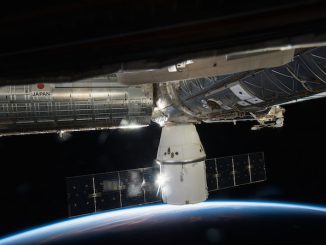
Astronauts Randy Bresnik and Mark Vande Hei plan to head outside the International Space Station Thursday on a spacewalk to replace one end of the lab’s Canadian-built robotic arm, a changeout that engineers say will restore the device to full capability.
The spacewalking duo is scheduled to officially began their excursion around 8 a.m. EDT (1200 GMT) Thursday. The spacewalk is expected to last around six-and-a-half hours.
Bresnik, commander of the station’s Expedition 53 crew, is making the third spacewalk of his career. Vande Hei will conduct his first spacewalk Thursday.
The astronauts’ main task Thursday will be the swap of a degraded Latching End Effector on Canadarm 2, the 58-foot (17.7-meter) robotic arm used to capture and release visiting logistics vehicles and move equipment around outside the space station.
Ground controllers noticed a problem with one of the arm’s two end effectors, called LEE A, in August, when latches inside the end effector stalled during a “walk-off” maneuver to relocate the robot arm.
Stalled latches inside the robotic arm’s end effectors are “quite unusual,” according to Tim Braithwaite, a space station program liaison for the Canadian Space Agency. “We took a really good look at all the data that we’re seeing, and basically that LEE A latch mechanism is telling us that it’s time.”
The robotic arm has shoulder, elbow and wrist joints like a human arm, giving it flexibility in seven degrees of freedom. The station’s robotic arm is a bigger, more advanced version of the appendage that flew on NASA’s space shuttles.
Thursday’s spacewalk marks the second major repair to Canadarm 2 since the shuttle Endeavour delivered it to the space station in April 2001. Shuttle astronauts replaced a wrist joint on the arm in 2002.
“The Latching End Effector … is a set of mechanisms that does all the heavy lifting, and does all the mechanical attachment when the arm walks end-over-end and establishes a new base point, when it picks up our two-armed robot Dextre to go do station maintenance, or when it catches or releases free-flying cargo vehicles,” Braithwaite said.
Canadarm 2 has two identical end effectors, each capable of serving as the arm’s base as it inchworms between attachment fixtures outside the space station. The LEEs route power, data and video between the space station and visiting supply ships, experiment boxes, or spare parts grappled by the arm.
Engineers designed major components of the robotic arm to last between 10 and 15 years, but the arm was intended to be repaired in space.
“Here at 16 years and counting, honestly, for an item this complex, we’re actually very pleased that both LEEs lasted this long,” Braithwaite said. “We thought that probably we’d be doing this maintenance before now.”
Each end effector is about the size of a mini-refrigerator and has a mass of more than 440 pounds, or 200 kilograms.
Once they arrive at the robotic arm worksite on the station’s truss backbone, Bresnik and Vande Hei will attach themselves to foot restraints on each side of the end effector. The spacewalkers will remove two thermal blankets, the release six bolts connect the end effector to the arm.
The astronauts will retrieve a spare end effector from the station’s mobile transporter, a cart that runs up and down the length of the truss. After transferring the spare to the waiting robot arm nearby, Bresnik and Vande Hei will inspect the interfaces between the arm and the fresh end effector, then begin a three-step procedure for re-installing bolts to attach the replacement.
The astronauts will first install four bolts to a low torque, then Canadarm 2 will be powered up and rotated to give the spacewalkers access to the other two bolts. Bresnik and Vande Hei will drive those two bolts to full torque, then tighten the four others, according to Jaclyn Kagey, NASA’s lead spacewalk officer for Thursday’s excursion.
Once they fasten thermal blankets back over the newly-installed end effector, Bresnik and Vande Hei will place the faulty unit on the mobile transporter, where it will serve as a storage port until astronauts on a future spacewalk bring it inside the station for eventual return to Earth.
Braithwaite said the end effector will be returned to MDA Corp. in Brampton, Ontario, the builder of Canadarm 2, for inspection and repairs. It could be re-launched to the space station again to become a spare in case another changeout is needed in the future.
Thursday’s spacewalk is the first of three trips outside the station planned this month.
Bresnik and Vande Hei plan another spacewalk Oct. 10, and astronaut Joe Acaba will join Bresnik for an excursion Oct. 18.
Plans for both spacewalks include lubricating the robotic arm’s new end effector, replacing cameras, and swapping out a fuse on the Dextre robot.
Kenny Todd, NASA’s space station operations integration manager, said the robot arm repair will ensure it is ready for the arrival of the research lab’s next cargo delivery next month, when an Orbital ATK Cygnus cargo craft is scheduled for launch.
Email the author.
Follow Stephen Clark on Twitter: @StephenClark1.



